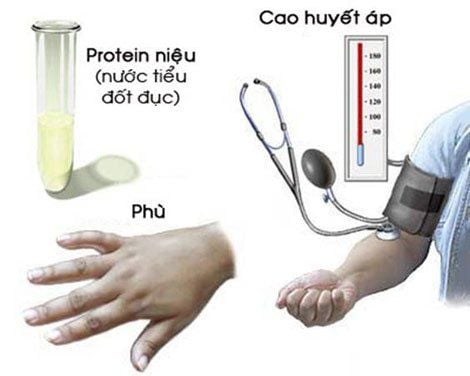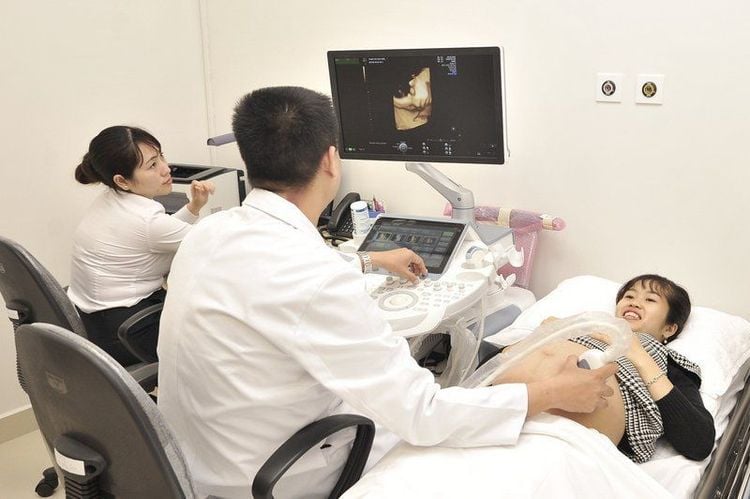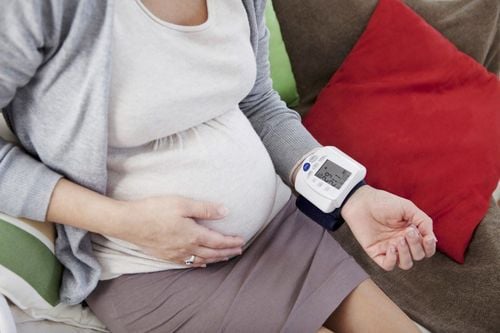This is an automatically translated article.
The article is professionally consulted by Master, Doctor Nguyen Thi Hong On - Department of Obstetrics and Gynecology - Vinmec Phu Quoc International General Hospital.
Preeclampsia is a condition in which blood pressure and proteinuria increase greatly in pregnant women, which, if left untreated, can cause many dangerous complications. The disease can be screened through several pre-eclampsia tests.
1. Harm of Preeclampsia
Preeclampsia is one of the serious obstetric complications in pregnancy, usually in the third trimester of pregnancy.Not only endangering the mother, pre-eclampsia is also one of the main causes of neonatal mortality because of the risks of preterm birth due to early termination of pregnancy due to fetal malnutrition, the risk of stillbirth, intrauterine growth retardation...

2. When to get tested for preeclampsia?
When there are some signs of pre-eclampsia, or the pregnant woman herself is at high risk of having the disease, she should go for pre-eclampsia testing. Early detection of pre-eclampsia is of great significance, helping doctors plan timely intervention and avoid dangerous complications for both mother and baby.Early signs of preeclampsia can be:
Sudden rise in blood pressure, often above 140/90 mmHg. There is protein in the urine, usually albuminuria greater than 300 mg/24 hours. Urinating less, oliguria, or kidney problems. Headache, upper abdominal pain, vomiting and nausea. Vision changes such as temporary loss of vision, blurred vision, sensitivity to light. Decrease in blood platelets < 100,000/mm3 Liver function is impaired. Difficulty breathing due to fluid in the lungs. Whole body edema.

Having a personal or family history of preeclampsia. Maternal age over 40 years old. Obesity Multiple pregnancy History of: chronic hypertension, diabetes mellitus, renal disease, systemic disease (eg, lupus erythematosus, ...)
Trắc nghiệm: Dấu hiệu tiền sản giật là gì?
Tiền sản giật là 1 trong những biến chứng của thai kỳ đặc trưng bởi huyết áp cao và có dấu hiệu tổn thương hệ thống cơ quan khác, thường là gan và thận. Tiền sản giật hay gặp ở sản phụ mang thai sau 20 tuần, việc nhận biết các dấu hiệu sớm của tiền sản giật là vô cùng quan trọng để can thiệp kịp thời, bảo đảm sức khỏe cho mẹ và con.The following content is prepared under supervision of Thạc sĩ, Bác sĩ y khoa, Tạ Quốc Bản , Sản phụ khoa , Khoa Sản phụ khoa - Bệnh viện Đa khoa Quốc tế Vinmec Phú Quốc
3. Pre-eclampsia screening test
3.1. The basis of pre-eclampsia screening
The diagnostic criteria for preeclampsia are mainly based on high blood pressure and proteinuria (proteinuria). Currently, the introduction of a blood test method that can help detect early signs and symptoms can be performed right in the first trimester of pregnancy, thereby effectively supporting the diagnosis and short-term prognosis. risk of preeclampsia.With the above method, the pregnant woman will be assigned a blood test to determine the ratio of sFlt-1/PlGF (sFlt-1 is anti-angiogenic factor and PlGF is an angiogenic factor).
Normally, sFlt-1 and PlGF levels change with each stage of pregnancy. There is a change in the concentration of these two factors, before the appearance of clinical symptoms of preeclampsia, leading to an increased sFlt-1/PlGF ratio. Therefore, this change in concentration can be considered for early prognosis of complications.
3.2. Pre-eclampsia screening test procedure
Screening for pre-eclampsia in the first trimester of pregnancy is usually done at the same time as the combined test (screening for chromosome abnormalities 13, 18, 21) at 11 weeks to 13 weeks and 6 days because it can test on the same blood sample. This type of test is non-invasive and completely harmless to mother and fetus.Step 1: Collect information of pregnant women about their medical history and family, age, weight and height.
Step 2: Blood test
Pregnant woman's blood sample from 11 weeks to 13 weeks and 6 days to measure the concentration of PlGF (Placental growth factor) in the mother's blood.
PlGF is a substance secreted by the placenta and is a proangiogenic protein involved in the regulation of placental vascular development and maternal endothelial function during pregnancy. Normally, PlGF increases in the first 2 trimesters of pregnancy and decreases gradually in the 3rd trimester of pregnancy. In pregnant women at risk of preeclampsia, this substance is greatly reduced in the mother's blood during pregnancy.
Step 3: Measure average arterial blood pressure
Measurement method:
Maternity rests for 3-5 minutes, sitting in the correct posture, two arms measuring BP are placed at heart level, feet touching the ground, psychological and emotional comfortable sitting position. Using an automatic BP meter, measure both hands at the same time, with the appropriate cuff size. Measure twice and average for each hand and for both hands. The size of the cuff is based on the circumference of the arm in the middle of the humerus (small size: < 22 cm, medium size: 22-32 cm; large size: 33-42 cm) Mean arterial pressure = (systolic BP – diastolic BP)/3 + diastolic BP Step 4: Abdominal ultrasound measure uterine artery pulse
The main pathogenesis of preeclampsia is impaired infiltration of trophoblastic cells of the torsion artery system and failure to remodel into blood vessels at the uteroplacental exchange bed increases the impedance in the outflows.
In normal pregnancy, uterine artery impedance will decrease with gestational age, but in preeclampsia and growth retardation pregnancies, impedance index will increase. The above information will be combined with algorithms to draw conclusions about the risk of preeclampsia.

4. What is the meaning of pre-eclampsia screening test?
This is a screening test, not a diagnostic test. The test has a sensitivity of 90%, false positives of 10%. The test shows that the risk of pregnant women having preeclampsia at < 32 weeks and < 37 weeks of pregnancy is high or low. Low-risk outcome: Pregnant women are unlikely to develop preeclampsia. However, pregnant women should continue to have regular antenatal check-ups and follow-up as usual, because screening tests are not absolutely 100% accurate. High-risk outcome: Pregnant women will be closely monitored by the doctor and have an appropriate intervention plan. If a woman is in a high-risk group for preeclampsia, her doctor will advise and prescribe preventive medication. According to the ASPRE study, in screened high-risk pregnant women with pre-eclampsia, aspirin use (150mg daily, evening) started before 16 weeks of gestation and continued up to 36 weeks of gestation was shown to be effective in preventing pregnancy. Preeclampsia <34 weeks is more than 80% and <37 weeks is more than 60%.For early detection of preeclampsia, it is best to have an early antenatal checkup. Mild cases of pre-eclampsia can be treated at home, eat light meals, rest with a lying position to help blood flow through the fetus more easily. A prenatal visit twice a week to check blood pressure, urine tests, and to check on fetal development. If severe preeclampsia occurs, the disease must be terminated immediately by delivery of the fetus, even if the fetus is still premature to avoid the risk of serious complications and death for the mother.














